
Mrs. Gita Vadhwana
VATA BALANCING FINALLY!
A HANDBOOK OF SIMPLE REGIMES
Dedication
This book is dedicated to His Divine Grace A.C. Bhaktivedanta Swami Prabhupada, Founder Acharya of the International Society for Krishna Consciousness.
He has made available Ancient Vedic Knowledge coupled with the lifestyle to develop spiritually in the modern setting.
To my daughter Neela who nursed me in trying times.
To Dr. Sananda, jps (Dr. T. Sukumaran, BAMS) who guided me in Vata Balancing Regimes.
Publisher’s Note
Mrs. Gita Vadhwana has a great passion to share knowledge from the Vedic Culture. Even though she was born and brought up in a foreign country, her enthusiasm to maintain the values of Vedic Culture is very noteworthy. Her participation in ISKCON (International Society for Krishna Consciousness) since 1969 has enhanced her knowledge in Ancient Indian Spirituality and thus she is able to share it with great ease. She travels extensively to hold seminars, workshops and retreats on subjects of Ayurveda, Vedic Culture and Spirituality.
This Vata book is the first in the series. We wait to publish her future works with much eagerness. Her forthcoming books are “Ekadasi (Non Grain) Recipes” and “Reasons and Meaning of Diwali Celebrations”.
Mr. Prakash Bhosle, Publisher at www.ebrandingindia.com
Author’s Preface
Ayurveda is a Sanskrit term wherein Ayur means longevity and Veda means knowledge. Thus, Ayurveda teaches us how to live a long healthy life in harmony with nature. In this system, the five elements; earth, water, fire, air and ether combine to form the three main doshas or energies which are termed as kapha, pita, and vata.
Excess vata in the body is called a vata imbalance which is a debilitating condition and should be adjusted immediately. It is an excess of air and ether elements in the body. This is fully explained in the ancient Indian medical system; Ayurveda. This handbook gives simple, easy to follow daily regimes to bring vata into balance.
Dr. Sananda Sukumaran brought this awareness to me and helped me in my journey to health. That is why I want to share what I have learnt with others who may need this knowledge. I want to thank Bhavani Dasi (Beryl Trimble) for having unlimited patience to read through my original manuscript. I want to also thank my daughter Neela, who has helped me tremendously to manage my vata during those trying times.

Mrs. Gita Vadhwana
Introduction
Without a doubt the 21st century has divorced us from our natural environment with the onslaught of pervasive technologies.
Our lifestyles are dependent on the use of cars, mobile phones, televisions, computers and so many electric gadgets. All these items can disrupt the vata dosha in our bodies. They create imbalance due to excess air and ether from the electro-magnetic currents emitted by them. Many scientific studies have shown the detrimental effects of the modern technologies that emit these currents.
The human body is made to live in harmony with nature, that is, to live near clean water, fresh air, sunshine, trees, grass and natural environment in a joint family situation. The current culture of individualism and urbanization deprives us of this setting, which can be why health problems begin from a young age.
Having been a victim of this, my search for remedies opened the doors to Ayurveda. I found that simple forgotten techniques like vata balancing mudras, (simple hand gestures used for health), using kajal (eye ointment) and walking bare foot on the ground are just a few regimes which bring vata into balance. I know that, following a few of the techniques listed in this handbook, or all of them, will certainly balance vata in your body. Most of these techniques are recommended by Ayurvedic practitioners.
Grounding is a method which helps a person to be centered in oneself, be stable and balanced. The main text of this book consists of many techniques to reach this goal and be balanced. In material nature there are three subtle forces that influence our behaviour in every aspect of our physical, mental, and emotional life, including food and various activities. They are called Modes or “Guna” of goodness or “sattva”, passion or “rajas” and ignorance or “tamas”.
In the diet section of the book, I have left out foods in the modes of passion and ignorance like onions, garlic, leeks, meat, fish, eggs and mushrooms. These foods create unhappiness, misery, disease and ignorance. The sattva-guna (mode of goodess) creates an atmosphere of peace, serenity, and harmony in our environment and ourselves. Therefore the foods in this mode are recommended. These foods are succulent, juicy and nourishing and pleasing to the heart. They promote life, vitality, strength, health, happiness and satisfaction. In pure goodness lifestyle called “sattva guna” one will not only feel peace and calmness, but will experience real bliss and joy at soul level. In our recipes we have chosen the foods from this food group. More information on this topic is available in the age old book called “Bhagavata Gita As It Is”, Chapter 17.
It is a myth that meat consumption can balance vata. What to speak of the reaction created from the negative karma of killing animals. Laws of karma are explained in all authentic religious scriptures; and include that eating and killing animals creates sins for which one has to suffer the reactions. This suffering is called karma. Therefore we should avoid all non-vegetarian foods. There are many vegetarian proteins that can ground a person.
Questionnaire to Check Vata Imbalance
Vata is one of the subtle energies that govern the physiological aspects of person according to Ayurveda, which is a 5000 year old health science from India.
Please answer with a Yes or No:
• Do you use a cell phone?
• Are you constantly working on the laptop or computer?
• Do you travel a lot by trains, buses, planes, cars or any other such means?
• Do you live on the higher floor of a skyscraper?
• Is your work place in a high storied building?
• Are you exposed to a lot of air pollution?
• Do you suffer from anxiety, stress, and worry, lack of sleep or fear?
• Are you fickle minded, erratic or unorganized?
Do you easily get nervous, have mood swings, artificial enthusiasm and tend to forget things very quickly?
Are you restless both physically and mentally?
If you answer ‘yes’ to most of these questions, this signifies a probable predominance of vata in your body. If you are sure that you have vata imbalance, then you can use this book to help balance your vata in the case of minor imbalances or as prevention. In serious cases you should take full guidance and direction of a medical doctor.
Almost all of the regimes listed in this book were part of a person’s daily life in Vedic times, however, because of modernization, people have come away from them in the cultures they were rooted. The last few sections may seem like religious rituals, but in this era of the dawn of the New Golden Age, many people from all walks of life and cultures are familiar or introducing them in their lives and practicing some of them because of their scientific basis and the health benefits derived.
Description of Vata
Vata is one of the body types or subtle energies according to Ayurveda which signifies predominance of air and ether in a person’s constitution.
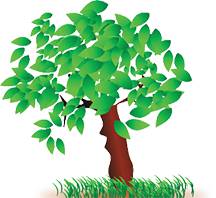
Vata when translated means ‘wind’ and it also shares similar characteristics to the wind. Vata governs the ‘movements’ in the body which includes nerve impulses, movement of muscles, blood flow, the elimination of body wastes, breathing and controlling thoughts. Vata is comparatively a very delicate dosha which easily gets imbalanced. It is a more predominant dosha, energy or body type in babies and the elderly; and therefore they may need extra personal care with this dosha in mind. Vata is also more prominent during the autumn and winter seasons thus special foods, diets, regimes and extra clothing are used during those times.

Since vata controls the activation of the nervous system, it is important that the vata remains balanced. Imbalanced vata affects the coordination of movement, conduction of the impulses and can contribute to the degeneration of the myelin sheaths (the fine covering of the nerves) causing conditions like MS or Multiple Sclerosis. Myelin depleted nerves cause electrical shocks thus interrupting the impulse conduction. This condition is dangerous, in the sense that it can cause serious mental disorders. Taking care of vata balance can assist in the body’s internal corrective processes.
Principles of Ayurveda
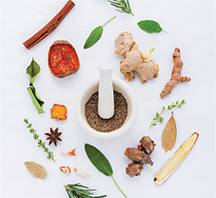
Ayurveda says that five natural material elements; earth, water, fire, air and ether combine in the human body and are then represented by three doshas. Doshas are energies called kapha, pitta and vata. Kapha comprises of earth and water, pitta is composed of water and fire and vata is made up of air and ether. A healthy body has these three doshas in balance according to one’s natural state. Although, we are all made of various degrees of combinations of these doshas, excess in any of them will lead to various health conditions.
Tridosha (Three Doshas)
Tridosha is a unique concept to the Vedic modality of health and wellness. Ayurveda states that the body is composed of dhatus (tissues), malas (the waste products) and doshas (energetic forces). The Tridoshas are responsible for the creation of the body’s tissues, elimination of waste, functioning of the sensory organs, all movements and bodily activities.
Generally there are varieties of combinations of doshas. For example, Vata-predominant, Pitta-predominant, Kapha-predominant. Then there are three dual Prakritis (natures), where two doshas are equally or nearly equally predominant: Vata-Pitta predominant, Pitta-Kapha predominant and Vata-Kapha predominant; a balanced person has all three doshas in equal proportion. This may be in a case of a monk who is very peaceful and detached from all worldly affairs. This is very rare among regular working people. In order to find out your dosha, you can take a dhosa test from any Ayurvedic book, or have a consultation from an Ayurvedic doctor which should give you an accurate analysis. Of the three doshas, vata is the most powerful as kapha and pitta cannot function without it Most sicknesses are due to an imbalance of the vata dosha. It is recommended that vata dosha be addressed first because it is dangerous to leave it uncared for.
Characteristics of Balanced Vata
When vata is in balance a person appears lively, vibrant, alert, enthusiastic, creative, flexible, imaginative, sensitive, prompt and active. A vata person loves excitement and new experiences because he or she gets bored easily and needs new stimulus for the mind, body and intellect.
Symptoms of Imbalanced Vata
With vata imbalanced in the body and mind, we might appear restless and uneasy, experience anxiety, stress, sleep disorders, forgetfulness, constipation and suffer from colon disorders, excessive weight loss, dryness of skin, arthritis, heart disorders, infertility and asthma. Also we can be vulnerable to frequent headaches, bloating, feelings of tiredness when talking or thinking, fatigue and lethargy, incongruence of thoughts, fast speech, short temperedness and edginess. Nervous system disorders could be attributed to vata imbalance, common modern day disorders include Parkinson’s disease, or schizophrenia which is characterized by bizarre or paranoid delusions, hallucination, disorganized thinking and speech.
Causes
Vata is aggravated by irregular routine, erratic climate, having meals at inappropriate times sleep deprivation, stress, and anxiety, consuming too many pungent or bitter foods, injury, travel, and certainly overuse of modern gadgets like cell phones, computers, television, video games, cars, planes etc. Sometimes prescribed medications, recreation drugs or alcohol can be the cause of vata imbalance.
We are not suggesting changing your lifestyle drastically but helping to make awareness of such dangers so as to be empowered to support your health. The simple techniques mentioned in this book will not only help alleviate vata imbalances but will allow you to use the modern gadgets in a balanced way. A list of suggestions for better use of these gadgets and appliances in the house is included at the end of this booklet.
Vata Balancing Regimes Introduction
The basic goal is to bring vata into a state of balance by regulating healthy habits in daily life and to gradually minimize the excess of vata harming items.
This is achievable by following a recommended vata diet, avoiding certain foods and consuming more of others. Applying oil on the body which can be done in five minutes daily by yourself to reverse the ‘dryness’. Exercise as per body type and needs. Meditating everyday for five to twenty minutes, and/ or reciting quiet mantras or performing japa to stabilize the thought processes.
Repeating a Mantra or a spiritual sound vibration on prayer beads, normally named a rosary, is called japa. Most prayer beads have 108 beads and one should recite a mantra on each of these beads. This method surely helps in calming and focusing the mind. The most commonly used mantra is as follows; Hare Krishna, Hare Krishna, Krishna Krishna, Hare Hare, Hare Rama Hare Rama, Rama Rama, Hare Hare. All the names mentioned in this mantra are recited on each bead. In the beginning it may take a person about ten minutes to recite these mantras on all one hundred and eight beads. Later on the time will be reduced to five minutes.
By using these techniques you should certainly feel calmer and have a more relaxed nervous system. The overactive mind will be stable and will focus with clarity. Many other vata balancing regimes are given below. You can gradually add more balancing activities in your life as you get familiar with them. We have included a daily record chart at the end for your convenience. If you achieve these goals, then our endeavour in producing this handbook has been worthwhile.
Daily Vata Balancing Regimes
Waking Up at Brahma Muhurt (4.00 am to 6.00 am)
Brahma Muhurt is the couple of hours before the sunrise on the equator or tropics. This time is highly recommended for spiritual and meditation processes because it is very peaceful time. Generally people have not yet woken up, and therefore there is less activity e.g. there are hardly any traffic noises. At this time the divine energies are at their peak potencies. Waking up early in the morning is good for balancing vata, the most ideal time would be around 6.00 am. Ayurveda and Chinese health systems show the specific times during which various organs in the body rejuvenate during the night. We have included this Chinese organ regeneration clock in this handbook.
Regularity is the biggest challenge for vata types. Irregularity ruins the natural body clock cycles or rhythms thus bringing imbalance. Thus early bedtime is important for vata individuals because they need at least six to seven hours sleep.
Yoga Nidra, Meditation, Pranayam and Prayers

Yoga Nidra is the best way of balancing vata in the mornings. You can perform this while still lying in bed. Slowly touch each part of your body or call out quietly in your mind, “I relax my toes, I relax my feet, I relax my ankle and so on.” This process takes about five minutes but it is very effective after the first prayer in bed to calm the restless mind. This ensures that you are acknowledging every part of your body which aids in relaxing various limbs and organs.
Before leaving your bed sit upright for about five to twenty minutes and focus on your breathing or perform meditation. I find that meditation calms the nerves and mind. Deep breathing happens automatically after 20 minutes of meditation. After that I do pranayam (alternative nostril breathing). This can also be done in the evenings too before going to bed because it helps cleanse the meridians of the body and ensures peaceful sleep. It is a good time during morning meditation to listen to music (raga, melodies) or Sanskrit prayers. The prayers bring in a connection of the soul to the Supreme Soul and thus results in grounding vata and giving inspiration for the day.
Mantra Bath
Taking a bath should be a part of a daily routine especially in the morning. Bathing gets rid of dirt, sweat and tiredness, thus rejuvenating and cleansing the body and aura. Adding some mantras to the bathing water constitutes a ‘mantra bath’ which helps in purifying the soul. This can be done by invoking the presence of holy rivers like Ganga, Godavari, Sita or Saraswati, by reciting their names and touching the bath water. Mudras (hand gestures) are used to direct the positive energies of these mantras into the water. This is not merely a religious ritual but also backed by science. Proper method can be learnt from a Vedic priest. This method requires a bucket bath instead of rushed shower, thus saving gallons of waste water.
Calming essential oils can be added to bathwater. Sometimes coloured baths are used for healing various ailments. These are special colour therapy baths.
Oil Application to the Head and Body (Abhayanga)
Give your body a soothing oil rub with some warm sesame oil, essential oils can be added according to your preference. The skin, being the largest body organ immediately feels relaxed and calms the nerves. You can put a small amount of Brahmi or other flower scented oil on the centre of the head and rub it gently with your palm, if you prefer not to make the whole head oily.
Ear Drops (Karana Purana)
After the morning duties, an application of sesame oil in the ears called ‘karanapurana’ is done. Care needs to be taken to not harm the ear drums; hence the oil application in the ear should be done by dipping a Q-tip (cotton bud) in the oil and then gently rubbing it into the ear. A favourite essential oil can be added for better fragrance. This method is very beneficial before travelling in a modern vehicle like car, plane or train (or any fast vehicle). Speed travelling immediately creates vata imbalance because it is unnatural for the body to be moving very fast.
Essential Oils

Essential oils are also known as volatile oils or ethereal oils. Oil is “essential” in the sense that it carries a distinctive scent or an essence of the plant.
Vata types need oils that help to ground, balance, and warm their dosha. Make use of perfumes that are made out of the fragrances of essential oils and natural scents. These fragrances soothe the senses and nerves and bring the feeling of joy, upliftment and freshness. They provide the body with vitality and help improve self esteem in addition to many other benefits, according to their properties. Recommended vata balancing oils are as follows: Amber, angelica, anise, basil, bergamot, camphor, cardamom, chamomile, cinnamon, clary sage, coriander, eucalyptus, frankincense, geranium, ginger, jasmine, jatamansi, lavender, lemongrass, myrrh, neroli, patchouli, rose, rosewood, sandalwood, sweet orange, tangerine, thyme, vanilla, vetiver and ylang ylang. Carrier oils like sesame, avocado, castor and coconut can be used to add a few drops of essential oil for daily use. These essential oils are brilliant for jet lag.
Gemstones

Gemstones also are composed of the five elements and have been used in the Indian system of healing for eons. They fortify the imbalance and bring the human body and mind to a state of homeostasis and harmony. Each gemstone has its own feature. For instance, emerald calms an aggravated mind, aquamarine helps sleeplessness, onyx and yellow sapphire is good for stabilizing emotions, yellow topaz and heliodor are used for a shy, introvert and self defeating person, ruby is used in case of painful joints. Red garnet helps in sudden weight loss.
Colours & Clothing
Dress to be comfortable. Wear clothes that are made of natural fibers like silk, cotton, wool or linen. It is good to choose vata balancing colors. Colours play an important role in healing the body both mentally and physically. Natural fibers absorb and attract positive energies whereas synthetics interfere and create static electricity. All shades of red, orange, yellow and browns are warm and compatible for vata types on the body. Shades of green can also be helpful. Best to avoid white, violet, and blue since like attracts like and vata is represented by those colours which are considered higher frequency colors which bring in the opposite effects to grounding.
Colours & Environment
Honour your space. Create a safe, calm and secure environment at home and at work. Turn your space into a sanctuary that truly nourishes you. Live plants, greenery and flowers, uplift the mood and calm the nerves. It is also noted that working and living in surroundings with calm and peaceful colours increases productivity and ensures harmony. Gold and browns are used for grounding. Yellow, orange and earthy warm colours will balance vata. Greens will bring peace and calmness. Avoid bright red because of its stimulating effects.
Feng Shui, the Chinese technique of Vastu is very helpful for health and general wellbeing from all aspects.
Yantras & Mandalas
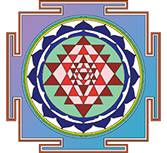
Very often yantras and mandalas are used for balancing doshas. These are called sacred geometry. Many researchers have found the healing effects of mandalas to be available simply by looking at them.
In Vedic times every home used to have a newly drawn fresh mandala with organic herbal dyes, grains or flowers at the doorstep daily. This system is still current in South India. Mandalas are known for expansion of the mind, strengthening one’s intellect, balancing various organs in the body besides many other social and spiritual benefits. Modern medical science has found a similar technique of symmetrical drawings to help avoid Alzheimer’s disease in old age.
Yajnas (Small Fire Sacrifices at home)
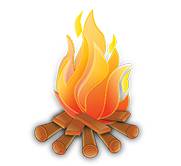
Yajnas are performed by adding ghee (clarified butter) and some grains in an organized, contained small fire in a vessel called yajna kund along with reciting Sanskrit mantras. Sometimes they are called Homas. Yajnas are usually performed by Brahmans on various samskar days like birthdays, anniversaries, starting and finishing of school and college education, and entering a new home etc. Metaphysical sciences have proven that the smoke from yajnas because of the combined sanskrit sound vibration have tremendous healing powers. Yajnas give social and spiritual benefits in a person’s life. Many western people are presently performing these mini yajnas individually daily in their homes because of these benefits. Although most people understand these to be solely religious rituals. They have yet to understand the scientific and health benefits derived as is being gradually revealed by many Vedic Educational Institutes.
Mudras (Healing Hand Gestures)

Mudras are simple hand symbols or gestures that are often part of a morning puja (ceremony) and sadhana (daily spiritual discipline). One will be amazed at the benefits of these symbols. If you are not used to sadhana practices, then you can use the vata mudra alone and reap the benefits. These Ayurvedic methods of hand mudras, breathing techniques like pranayam and yoga asanas are zero cost methods of self healing.
The five fingers of the hand are regarded as representative symbols of five elements in the body. For example the thumb represents fire, index finger represents air, middle finger is for ether, ring finger represents earth and little finger represents water. Disturbance, disorder or deficiency in these elements or the consequent disease or imbalance can be rectified and cured by appropriate practice of suitable mudras along with other regimes.
A Vata balancing mudra can be performed by the index finger being folded to touch and gently pressing the root of the thumb and then the top portion of the thumb is made to touch the middle part of the finger in such a way that it also puts some pressure on the latter. This mudra regulates the mutual proportion and combination of fire and air components in the body.
Disorders caused by gases or air pressures in and around the veins, arteries etc., lead to vata ailments. Joint pain, arthritis, rheumatism, etc. are common examples of such disorders. The vayu (air) mudra helps control and cure excess vata ailments. The optimum time of practicing and the overall duration would depend upon the stage and type of the ailments. It is also efficacious in recovery from paralysis attacks. Best results are obtained if this mudra and the prana mudra are practiced together, one after the other. This vata mudra is also effective in alleviating toothache, headache, stomach ache, etc. Duration: 30 to 45 minutes every day, either at one stretch or in three parts (i.e., for 10 to 15 minutes, thrice a day). This mudra can be performed at anytime of the day.
Visualization and Chakra Balancing

This is one of the most powerful methods of healing because of the power of thoughts. One can create their own reality through this method. There are seven main different coloured chakras (subtle energy circles) in our subtle bodies. These chakras control the functions of organs which are in their regions of the body. If the chakras don’t function well or are closed then the organs linked with them get affected. In vata people the root chakra always needs help. Either it is distorted or closed. One can open the chakra with sound and colour and in one minute. The Sanskrit mantras and prayers have the hidden power to open the chakras. There are so many methods used these days to open these subtle energy chakras.
Method- Bring in red light with your mind from an imaginary white pyramid from above the head. Guide this red light going through all parts of the body and ending up in the root chakra. You can recite the word ‘Lam’ extending the sound for one minute, while doing this simple mental exercise for one minute e.g. Laaaaaaaaaammmmmmm. You can repeat this a couple times only, otherwise you will continue to yawn if you repeat this too often. Another quick method of visualization is to imagine roots coming out from the bottom of your feet and going deep into the earth and that you are leaning against a very large strong tree supporting your back, holding this thought for couple minutes. There are varieties of ways of using visualizations. There is an abundance of resources available in the subliminal therapies using sound and visualization. Vata people should find a method that works best for them to protect their aura (subtle protective energy around the body) from negative energies.
Nature Walks & Tai Chi
Take some time off from work so as not to over burden yourself. Take short breaks, walk in an open space to refresh your mind. Lush greenery, large trees and plants that are directly rooted in the ground are good for vata. Doing a few Tai Chi exercises helps during the afternoon. Having the company of a kapha person is very beneficial to the vatas.
Soothing Music & Kajal
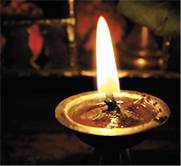
Evening meditation or sadhana with soothing evening ragas (tunes) are very relaxing and help to unwind. Massage or rub your feet for a few minutes with warm sesame oil before you go to sleep. Apply two drops of warm castor oil or homemade kajal (Indian eye ointment) in both your eyes to improve vision and ground vata. Kajal is made by simply holding stainless steel (two or three inches wide dish over a flame using castor oil or ghee wick. This is done for few minutes to make the carbon thick so it is enough to collect in a small container for storing for future use. The collected carbon from the bottom of the dish is called kajal. Another simple method is to burn an almond and to collect the carbon from its flame collected in the same way. Sometimes little castor oil and tiny bit of edible camphor is added to this carbon for further purification of the eyes. Camphor may sting the eyes a little but much benefit is derived to the eyes. One of the sitting places of vata is in the eyes. Therefore one will see Indian women wearing kajal everyday to be grounded. Presently chemical eye liners are used on the outside of the eyes for cosmetic purposes and the importance of kajal is almost forgotten.
Recreation
Beneficial activities for vatas include: SlowYoga, poses, Qi Gong, Tai Chi, walking, short hikes, slow bicycling, light tennis, golf, slow dance, and aerobics.
Movies: Vata people should avoid watching sad, violent or over stimulating movies.
Yoga, Japa & Sadhana (Spiritual Practices)
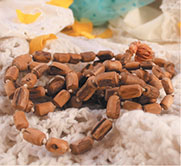
Practicing yoga and meditation helps to channel your brain waves in the right and positive direction. The twelve alternate nostril breathing is called pranayam and is the best suited yoga exercise for balancing vata, apart from the cat, camel, cobra and cow positions. If practiced regularly, it increases flexibility, physical strength and endurance in your body.
Surya Namaskar is called the king of all yogas. It can be performed without much exertion. There are so many kinds of yoga that confuse the layperson. For example hot and fast paced yoga are detrimental for vata people because they create a stimulating effect in mind and body.
Today’s life is filled with uncertainly and stress. People have strayed away from the basic meaning of life. Hence, it is very essential to connect with the Supreme Being and devote a few minutes to become one in Spirit. It is also recommended to read Holy Scriptures during early mornings, recite quiet mantras called japa meditation etc. Vedic spiritual sadhana is scientific and helps body, mind and spirit to boost energy in the mornings, relax in the evenings and protect one from all negativity all the time. This is proven by Spiritual Science Research Foundation organization (SSRF). Lighting of incense, ringing of bells and conch shells, performing a simple ceremony with bhajans and kirtans uplifts the soul, calms the mind and connects the soul to the Super soul. Thus, the natural Vedic lifestyle is adopted by many broadminded, spiritual and health conscious people even in Western countries now. The best example is the International Society for Krishna Consciousness (ISKCON). This society has many centres in all major cities in the world where people can learn and participate in these teachings daily. This morning and evening sadhana exposes one to natural aromatic healing substances like frankincense, aguru, sandalwood, Tulasi (holy basil), Ganges water, ghee lamps and beautiful audience of the deities, dancing and chanting to spiritual vibrations in congregation and reciting the Holy Scriptures. These are age old natural lifestyle habits which people have forgotten, thus we see so many health concerns in people’s lives today. If these daily routines are brought back, then a person’s life will be very uplifted, soothed, nurtured and rejuvenated; body, mind and spirit.
Vata Diet
Dairy Products
Dairy products are very important for vata balancing. Since the items are heavy, they help in grounding the vata immediately. Milk and ghee calm the nerves and help in regeneration and replenishing at the cellular level. Ghee is considered liquid gold in Ayurveda and it has many benefits. It helps in digestion, rejuvenation, is good for memory, and is used as a medium with herbal medications. It gives energy, strength and longevity. Ghee is also used externally in many ways. Internal use includes it being added to warm soups, dal and in milk. Pure and hot organic cow’s milk is known to assist in the regeneration of the myelin sheaths. Organic herbs like saffron, nutmeg, cardamom and or turmeric can be added to the milk as digestive aids. Many people these days have lactose intolerance from the effects of unnatural foods and too much toxins in the foods and air. Therefore organic milk is recommended. Presently the beneficial trend in the cities is to get raw organic milk without pasteurization or homogenization directly from small farms. One should find out if there are similar farms are in their local area. Consuming small amounts of cheese helps in grounding vata.
Breakfast
Food in the mode of pure goodness not only recharges the human body but helps to purify, mind, intellect and the soul. Thus, the ‘karma free’ aspects of food preparations are recommended. The ‘karma free’ aspect allows you to acknowledge and be grateful for all that is given to you by the Almighty. Thus, as an act of gratitude, you make an offering of the food stuff to God first before tasting it and then partake it as mercy in gratitude. This helps in purifying a person’s consciousness and charges them with endurance and strength.
Breakfast is essential for early morning grounding. Warm cereals, cream of wheat or rice, hot porridge and some dairy will make a hearty meal. Other cultures have similar grains for morning meals. For example small amount of semolina halva or vermicelli or dosas (indian crepes) are used in other cultures. Some people use whole grain breads, pancakes or crepes.
Recommended Foods
Consuming the right kind of food is the key to healthy living. Since vata’s attributes are dry, cold, hard, rough, and light, therefore opposite elemental foods should be used to bring balance. Thus tissue-building and nutritive food items that are moist, warm, soft, oily and heavy are used. Food items that are sour, sweet and salty to taste should be used in the diet.
An individual having a vata imbalance must favour food items like hearty soups and vegetables, chapattis, breads and whole cooked grains. Spicy food items are usually okay for vata balancing. Below are recommended foods for balancing vata.
Legumes: Green and Black Mung beans, Aduki or red small beans are good for vata. They should be cooked thoroughly. Other beans may be too dry for the vata people.
“Dal” is a simple recipe to make. Simply thoroughly boil the beans, then in a separate pan, take a little ghee and add spices like cumin seeds. When they pop, add half teaspoon of grated ginger and tumeric powder. Then add the cooked beans and salt as desired. This is delicious with rice.
Vegetables: Beetroot, Spinach, Avocado, Carrots, Asparagus, Pumpkin, Sweet Potato, Eggplant, Zucchini, Radish, Olives, Okra, White pumpkin, Celery root, Artichoke, Turnips and Bell peppers. Best if all the foods are cooked. Raw vegetables can be taken with oil dressings.
Fruits: Berries, Apricots, Cherries, Banana, Pineapple, Kiwi, Coconut, Strawberries, Dates, Grapes, Plums, Mango, Peaches and Papaya.
Grains: Rice, Oats and Wheat
Vata Aggravating Foods to Be Avoided
Foods items that exhibit the characteristics of vata such as frozen desserts, crackers and raw vegetables, cold salads etc. should be avoided. Refined food items like sugar and white flour have dry and light attributes and hence should be avoided by the individuals with vata constitutions. Bitter, pungent, light, astringent, cold and dry, stimulants like alcohol, smoking, tea, coffee, junk food, sugar, brown rice etc. are best avoided.
Vegetables to be avoided: Raw Vegetables, Broccoli, Cabbage, Cauliflower, Brussel Sprouts, Peas, Celery, Potatoes. However they may be consumed by cooking them in sesame oil or ghee thoroughly. Tomatoes should be avoided or used very sparingly. They aggravate all doshas.
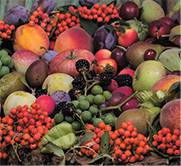
Fruits to be Avoided: Dried fruits (unless soaked overnight), Pears, Apples, Pomegranates, Melons, Cranberries.
Spices: Vatas can ideally have all the herbs and spices, but in moderation.
Herbs; the best herb for grounding vata is Brahmi. It can be obtained in powder, capsules or pills from Ayurvedic health stores.
When the vata seems aggravated, the following spices have to be consumed with caution: fenugreek (methi seeds), coriander (dhaniya powder), parsley, turmeric and saffron. Avoid the consumption of extremely hot spices like dried chilies as they will further aggravate the already existing dryness.
Food combinations to be avoided
Ayurveda states that there are certain food items with conflicting effects on the body, hence such combination of food should be avoided because they may lead to harmful chemical reaction during the digestion process. For instance, milk with orange, lemon, lime, pineapple, yogurt and radishes, yogurt with sour fruits and such combinations should be avoided.
Summary and Resources
With a little caution and attention to your body, you can help stabilize the vata dosha and ensure that you are free from all the afflictions that are accompanied due to the imbalance of this dosha.
Resources
The Meridian Organ Clock
The Chinese Acupuncture “Meridian Clock” is an example of a 24-hour cycle which portrays the body’s complete functions as well as its relationship with diet. There are 12 meridians, each taking the lead for two hours during the 24-hour period. Each of the 12 meridians has a dual flow, a coming and a going, marking 24 cycles per day.
The clock delineates which meridian system is activated and dominant at a specific time. Since these cycles happen automatically, we do not have to be preoccupied with them. However, if we know of these cycles, then we can make better decisions when it is generally best to eat, exercise and sleep. The following chart gives you the details of the 12 meridians with its respective best suited timings.
5 a.m. – 7 a.m. — Large Intestine — Drinking water triggers bowel evacuation making room for the new day’s nutritional intake. It also removes toxins from the night’s cleansing.
7 a.m. – 9 a.m. — Stomach — Stomach energies are the highest so eat the most important meal of the day here to optimise digestion/assimilation.
9 a.m. – 11 a.m. — Pancreas — the stomach passes its contents on. Enzymes from the pancreas continue the digestive process. Carbohydrate energies are made available.
11 a.m. – 1 p.m. — Heart — Food materials enter the blood stream. The heart pumps nutrients throughout the system and takes its lipid requirements.
1 p.m. – 3 p.m. — Small Intestine — Foods requiring longer digestion times (proteins) complete their digestion/assimilation.
3 p.m. – 5 p.m. — Bladder — Metabolic wastes from morning’s nutrition intake clear, making room for the kidney’s filtration to come.
5 p.m. – 7 p.m. — Kidney — Filters blood (decides what to keep, what to throw away), maintains proper chemical balance of blood based on nutritional intake of day. Blood works to deliver useable nutrients to all tissues.
7 p.m. – 9 p.m. — Circulation — Nutrients are carried to groups of cells (capillaries) and to each individual cell lymphatics.
9 p.m. – 11 p.m. — Triple Heater — the endocrine system adjusts the homeostasis of the body based on electrolyte and enzyme replenishment.
11 p.m. – 1 a.m. — Gall Bladder — Initial cleansing of all tissues, processes cholesterol, enhances brain function.
1 a.m. – 3 a.m. — Liver — Cleansing of blood. Processing of wastes.
3 a.m. – 5 a.m. — Lung — Respiration. Oxygenation. Expulsion of waste gasses.
Beneficial Information for EMF (Elecro-Magnetic-Field)
Description for EMF.
EMF stands for electromagnetic fields, which are invisible electrical and magnetic forces. Everything generates an electromagnetic field. The natural earth creates one, and so does the human body. You create an EMF of about 10 hertz.
Artificial electromagnetic fields are caused by human activities and technologies (from appliances to cell phones to high voltage wires). These EMFs have been shown to cause biological stress.
Studies have shown EMF exposure above 2mG (milli-Gauss) will start to develop biological stress.
Evidence links prolonged exposure to levels between 2 and 12mG+ with cancer and possible immune system effects.
Exposure to 12mG suppresses the human hormone melatonin (critical for sleep, mood regulation, and overall health)
EMF & Health Problems
Widely published, peer reviewed scientific studies document the many effects of high EMF exposure levels, from fatigue to chromosome damage that can lead to cancer and other serious illnesses.
Unless you live in an isolated rural area, you are probably being exposed to an unhealthy level of EMFs day-in and day-out.
Protection from EMF Pollution Produced By Household Appliances.
• Purchase new appliances. The older your appliances, the greater the risk, as more EMFs are emitted.
• Keep your distance! EMFs are strongest at 2-3 feet or closer.
• Limit the time you spend around your home’s electrical appliances.
• Place all clocks, cell phones, cordless phones and other electrical devices at least 6 feet from where you sleep.
Best EMF Home Protection
Utilize Safe Space Products to counter artificial EMFs, restoring coherence and balance to the fields around you by setting up a “corrective resonance.” In other words, they alter the EMF, changing it from harmful to harmless.
Safe Space products are affordable, easy to use and proven effective in independent laboratory studies. See below for products recommended for protection from the effects of EMF fields in the home produced by appliances.
Electromagnetic Spectrum in Your Home – EMF Danger Spots In Your Home
Circuit Breaker
These produce very high toxic readings, into radio wave frequencies and even microwave frequencies. This is because the electric wires attach to a fuse box draws a lot of electricity
Air Conditioners
Air conditioners can emit EMFs as high as circuit breakers. The older the AC unit, the greater the dangerous EMF radiations it would have.
In-Floor Electrical Heating
This mode of heating utilizes electrical wires that are embedded right into a home’s wood or concrete flooring. EMFs can reach 100mG+ at the floor and 30mG+ at waist height.
Fluorescent Lighting
Fluorescent lights create a higher level of EMFs than incandescent bulbs. A typical fluorescent tube may have a reading of 160 to 200mG at 1 inch away. Even electromagnetic radiation from a compact fluorescent light can be problematic.
Halogen Ceiling Down or “Can” Lights
These lights require a transformer that can transmit EMF upward as well as downward, which means rooms above as well as below are affected.
Electric Sockets
Anything that’s plugged into a wall socket gives off an electromagnetic field (EMF) of 50-60 hertz, even if that appliance is turned off.
Cordless Phones
Cordless phones emit a tremendous amount of toxic radiation—twice as much as cell phone masts! The danger is in the handset as well as the base stations, which continuously give off harmful radio waves well over 100 hertz every hour of the day.
Recently, the British Health Protection Agency found one of the causes of neuromas (tumours deep in the ear) is cordless phones. For cordless phones users the incidence of acoustic neuromas doubles in just 10 years.
Telephone Landlines
Even the handset of a land line telephone emits high EMFs. The telephone receiver, the part held to your ear, carries a harmful south polar magnetic energy.
TVs & Computers
TV screens and computer monitors radiate EMFs of 60Hz or more. Older style televisions and computer screens produce radio-frequency fields of 10,000-30,000 Hz (10-30 kHz) as well as 60 Hz fields.
The Dangers of EMFS in Your Bedroom
Because people spend so much time sleeping, bedroom EMFs are a serious concern. The EMF exposure is typically less intense than that of a kitchen, but the exposure is prolonged.
According to guidelines, bedroom EMFs (especially in the area of your head) should remain under 1mG while sleeping and never exceed 2-4mG.
Electric Blankets & Water Bed EMF
Electric blankets and waterbeds are major EMF sources, all the more dangerous because of how close they are to sleeping people for so long. A recent study linked electric blankets to miscarriages and childhood leukaemia. Similar health issues have been reported by people who sleep on waterbeds, which utilise electricity to heat the cool water inside the mattress.
Exposure Levels
• 1mG or less: considered safe for sleepers.
• Above 2 Mg: begins to create biological stress.
• 8 Mg: electric blanket or waterbed heater on low.
• 21 Mg: electric blanket or waterbed heater on high.
• 6-7 inches: how far nearby magnetic fields penetrate into your body.
Electric Clocks
That electric clock next to your head could be emitting a magnetic field of 5 to 10mG—even up to a yard away—the EMF equivalent of an electric power line!
Electric Razors & Hair Dryers
Surprisingly, these every day use devices can emit EMFs as high as 200 to 400mG when turned on. Because of this, experts recommend hair dryers not be used on children, because fields that strong can damage rapidly developing brain and young nervous systems.
Reviews
1. Ananta Sakti – Author and Artist at Bhaktivedanta Manor, Watford, England This Vata Book is very easy to follow with the list of various regimes. I like the different colours of the titles from the text to distinguish it. The fonts are also appealing to seniors like me. Overall this book will be very helpful to everyone in the present day and age.
2. Shila Mistry – This is a very comprehensive book on the subject. It is nicely composed. You should not undermine its value.
3. Bhaktin Marion – (Spiritual Healer, Therapist) this was exactly the book I was looking for! Gita Vadhwana first gives us the symptoms and then proceeds to give the remedies in compact, clear and concise ways, needed for those with busy lives. This book surpasses other Ayurvedic books because it is specific about Vata imbalance. I will certainly recommend this book to healers and other friends.
4. Dr. Jyoti Dattani – Your book is very accurate and will benefit those people who will use it.
5. Vrindi – Munich – I really need this book. I am very thankful to you. I will start my regimes to balance my vata.
6. Lydia – Leicester – I am very thankful for this book.
7. Manager Herbal Veda – UK – This is a very good effort for Vata Balancing. I encourage you to compile a book for Kapha Dosa especially for European people.
8. Dr Sanjay Pisharodi aka Shyamavallabha das, rns Vrindavan, India: This book on controlling Vata is very good. It addresses the modern life style and its role in aggravating Vata. Many simple interventions are given which are easily implemented. I really appreciate Mrs. Gita Vadhwana’s enthusiasm and eagerness to help all the people of the world with the knowledge of Ayurveda.
Author’s Note.
I want to thank all my friends who have helped me in producing this little handbook. My gratitude to all the masters who are guiding us with their knowledge and research of keeping our body, mind and spirit healthy. My desire is that this handbook may be helpful to those who want to balance their Vata. Dosa.
Seeking your blessings.

Mrs. Gita Vadhwana
About the Author
Mrs. Gita Vadhwana is originally from East Africa raised by orthodox Indian parents. She came to London, England at a young age and tried to retain the Vedic Culture. Her family then moved to Canada where she lived for 30 years and learnt and taught Ayurveda and Bhakti Yoga to western audiences in many yoga retreats and studios. Since then she has been travelling and teaching in many countries to share her deep Vedic Understanding from both the spiritual and health aspects.
Copyright
AuthorHouse™ UK
1663 Liberty Drive
Bloomington, IN 47403 USA
Phone: 0800.197.4150
© 2016 Mrs. Gita Vadhwana. All rights reserved.
No part of this book may be reproduced, stored in a retrieval system, or transmitted by any means without the written permission of the author.
Published by AuthorHouse 07/28/2016
ISBN: 978-1-5049-9906-9 (sc)
ISBN: 978-1-5049-9907-6 (e)
Any people depicted in stock imagery provided by Thinkstock are models, and such images are being used for illustrative purposes only.
Certain stock imagery © Thinkstock.
Because of the dynamic nature of the Internet, any web addresses or links contained in this book may have changed since publication and may no longer be valid. The views expressed in this work are solely those of the author and do not necessarily reflect the views of the publisher, and the publisher hereby disclaims any responsibility for them.
